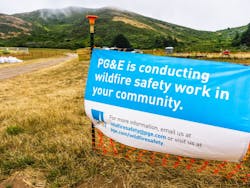Because of climate change and aging electric infrastructure, it seems that almost every season is now wildfire season in California. New Sun Road and Pacific Gas & Electric (PG&E) have announced a partnership that they believe will help to mitigate some of that wildfire risk with remote grids.
The utility recently selected New Sun Road’s Stellar Microgrid OS to manage and control its expanding fleet of remote grids situated across California in areas where fire threats are high.
Replacing wires with microgrids
PG&E’s renewable energy “stand-alone power systems,” or remote grids, are designed to replace long electric distribution lines in the threatened areas across the company’s 70,000 square mile service area. New Sun Road’s platform allows the utility to monitor and control the performance of its remote grids, run safety diagnostics and receive notifications over satellite or cellular connections.
Stellar Microgrid OS uses machine learning algorithms to optimize the performance and usage of clean energy. Jalel Sager, New Sun Road CEO and co-founder, said his company’s platform will ensure “maximized solar usage and high reliability” for PG&E and its customers.
In addition to replacing overhead distribution power lines, the remote grids can provide power during public safety power shutoffs (PSPS) in the event that there is a wildfire in the area.
Remote grids pass real-world wildfire test
PG&E’s first remote grid was deployed in Briceburg, California, and has been managed by New Sun Road’s monitoring and control platform for over a year. The companies report that it remained operational during the Oak Fire, despite many of the surrounding communities losing power because of PSPS.
PG&E said that replacing the overhead wires with remote grids can meet customer needs and significantly reduce the risk of sparking new fires while also decreasing lifetime costs.
California under pressure to ramp up microgrid development
California is one of the top states for microgrid policy activity, according to a recent report from Think Microgrid, a coalition affiliated with Microgrid Knowledge that educates regulatory and political leaders about the technology. But some still believe the state isn’t moving fast enough to pass microgrid incentives.
The County of Los Angeles as well as a number of advocacy groups are urging the California Public Utilities Commission (CPUC) to move faster on a $200 million microgrid incentive program that’s been approved but is waiting on the CPUC to set application requirements, scoring and other details. The grant program would help fund community, local and tribal microgrids.
Preparing to scale remote grids rapidly
Meanwhile, PG&E and New Sun Road plan to launch at least 30 additional remote microgrid systems by 2026. Four will be commissioned this year across Tehama and Mariposa counties, replacing 4.5 miles of overhead distribution lines.
Jason Glickman, PG&E’s executive vice president of engineering, planning and strategy, said, “As we expand the use of stand-alone power systems, we now have a standardized platform for our operations, engineering and asset management teams that will help us understand and manage real-time and historic system performance.”
PG&E said the arrangement to provide power to customers on the edge of the grid via its remote microgrids is now the best way to deliver lower-carbon, reliable local energy while also reducing the risk of sparking new wildfires in high risk areas.
Track news about utility microgrid programs. Subscribe to the free Microgrid Knowledge Newsletter.








